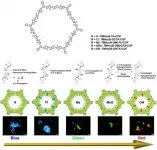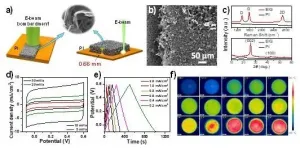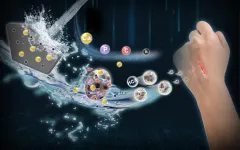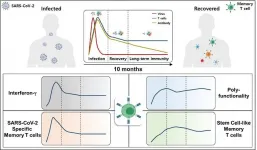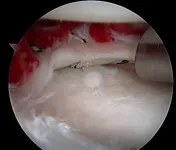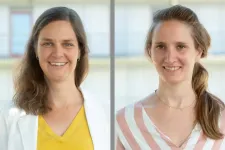AID/APOBECs among important factors in body's defence against SARS-CoV-2
A MedUni Vienna research team has now addressed the potential interrelations between AID/APOBECs and the SARS-CoV-2
2021-07-06
(Press-News.org) Together with their multifaceted action mechanisms, activation-induced cytidine deaminase (AID) and so-called APOBEC proteins are important factors in the body's immune response and offer fast and effective protection against a large number of DNA and RNA viruses. The task of AID is to strengthen the human immune response, while APOBECs are able to block the virus. A MedUni Vienna research team comprising Anastasia Meshcheryakova, Diana Mechtcheriakova and Peter Pietschmann from the Institute of Pathophysiology and Allergy Research has now addressed the potential interrelations between AID/APOBECs and the SARS-CoV-2 virus, particularly in connection with the course of COVID-19 in different patients. This could provide a starting point for future clinical strategies to improve and strengthen individual antiviral response.
The defence mechanisms associated with AID/APOBECs in response to the coronavirus were assessed on the basis of integrative data mining and gene expression analyses, as part of a study conducted with international partners. It was found that members of the APOBEC family are preferentially expressed in a particular type of cell or tissue: "However, this does not mean that a particular cell type only expresses a particular member of the APOBEC family but that each cell type exhibits its own characteristic APOBEC repertoire," explains Diana Mechtcheriakova.
What is completely new is that the researchers found that APOBEC4 is highly expressed in cells and tissues that are points of attack for SARS-CoV-2. These include epithelial cells in the bronchi, in the lungs, in the trachea and in the nose. It was also found that there is an extremely high level of expression of both molecules (one of the members of the APOBEC family and ACE2, the entry receptor for SARS-CoV-2), in the gastrointestinal tract, in the heart and in the testis.
"Based on this knowledge, the clinical challenge in the future will be to characterise the antiviral cell status attributed to AID/APOBECs specific to patients and/or patient groups and to correlate the cell-type-specific AID/APOBEC gene expression signature with the organs affected by SARS-CoV-2 infection and the severity of COVID-19," explains Mechtcheriakova.
A particular role in this process is attributed to AID, since it co-determines the strength of an adaptive immune response. "The AID-driven, highly coordinated sequence of events, which all occur in specialised immunological lymphoid structures with germinal centres, results in the production of high-affinity antibodies by plasma cells or memory B cells. These antibodies are directed against the pathogen causing the disease, such as SARS-CoV-2, either in the course of infection or of an immune response to a vaccine," explains Anastasia Meshcheryakova. The role of these complex lymphoid structures and of AID is of great importance for our further understanding of the pathobiology of COVID-19, and consequently for the development of new therapeutic approaches.
INFORMATION:
The results of the study have now been published in the journal Frontiers in Immunology. The study was funded by the "Medical and Scientific fund of the Mayor of the Federal Capital Vienna", the " Foundation Fund to Promote the Fight against Tuberculosis and other Lung Diseases" as part of the special SARS-CoV-2/COVID-19 call.
ELSE PRESS RELEASES FROM THIS DATE:
2021-07-06
Ishikawa, Japan - Many researchers in the field of materials science constantly seek novel and versatile platforms that can be used to tailor materials to match their intended use. One example of this are covalent organic frameworks (COFs), an emerging class of crystalline porous polymers with a favorable set of fundamental properties, namely crystallinity, stability, and porosity. This combination makes them, in theory, adjustable to many modern applications. Unfortunately, owing to the way COFs are usually obtained, these properties are not very pronounced, resulting in unstable, low-crystallinity solids with limited porosity.
At the Japan Advanced Institute of ...
2021-07-06
Recently, Prof. WANG Zhenyang's research group from the Hefei Institutes of Physical Science (HFIPS) of the Chinese Academy of Sciences (CAS) has prepared macroscopic thick three-dimensional (3D) porous graphene films.
Using high-energy electron beam as the energy source and taking advantages of high kinetic energy and low reflection characteristics of e-beam, the researchers directly induced polyimide precursor into a 3D porous graphene crystal film with a thickness of up to 0.66 mm. Related research results were published in the journal Carbon.
Graphene has been proved ...
2021-07-06
A new nanotechnology development by an international research team led by Tel Aviv University researchers will make it possible to generate electric currents and voltage within the human body through the activation of various organs (mechanical force). The researchers explain that the development involves a new and very strong biological material, similar to collagen, which is non-toxic and causes no harm to the body's tissues. The researchers believe that this new nanotechnology has many potential applications in medicine, including harvesting clean energy to operate devices implanted ...
2021-07-06
Recently, with the help of a steady-state strong magnetic field experimental device, scientists constructed nano-scale borate bioactive glass (Nano-HCA@BG), which can effectively reduce the biological toxicity of borate bioglass, improve the biocompatibility of the glass, and promote the effect of borate bioglass on skin repair.
Prof. WANG Junfeng from the Hefei Institutes of Physical Science (HFIPS) of the Chinese Academy of Sciences (CAS), collaborating with Prof. ZHANG Teng from Fuzhou University in this study, said, "it is expected to become the next generation of skin wound repair dressings." Related research was published in Chemical Engineering Journal.
Borate bioglass is a glass with boron element (B) as the glass network matrix. With good dopability and degradability, it ...
2021-07-06
Sleep deprivation - from lifestyle choices, pandemic stress, or late-night computer study - can quickly lead to loss of energy and function during the day and even feelings of anger and depression, an Australian sleep institute study has shown.
The study, led by Flinders University, asked 34 health teenagers (20 males) aged between 15 and 17 to spent 10 days and nine nights in a specially designed sleep centre.
They were allocated to one of three sleep 'doses' for five consecutive nights- from five hours, 7.5 hours, or 10 hours in bed per night - with two baseline and two 'recovery' nights of up to 10 hours' time in bed.
Their mood was measured every three hours after waking up to assess responses to feelings such as 'depressed', 'afraid', 'angry', 'confused', ...
2021-07-06
Wetland, forest, and ocean are the three largest ecosystems in the world. Although the area of wetland ecosystem accounts for only 4-6% of the total land area, the carbon reserves of wetland ecosystem accounts for 12-24% of the global land carbon reserves. Under the background of global climate change, the research on carbon sequestration of wetland has become an important subject of global carbon cycle research.
The area of marshes in China ranks third in the world, and herbaceous marsh is the most widely distributed among all the types of marshes. As an important quality parameter of marsh ecosystem, aboveground biomass of vegetation is a crucial index estimating the carbon storage of marsh vegetation, and the basis for studying ...
2021-07-06
A KAIST immunology research team found that most convalescent patients of COVID-19 develop and maintain T cell memory for over 10 months regardless of the severity of their symptoms. In addition, memory T cells proliferate rapidly after encountering their cognate antigen and accomplish their multifunctional roles. This study provides new insights for effective vaccine strategies against COVID-19, considering the self-renewal capacity and multipotency of memory T cells.
COVID-19 is a disease caused by severe acute respiratory syndrome coronavirus-2 (SARS-CoV-2) infection. When patients recover from COVID-19, SARS-CoV-2-specific adaptive immune memory is developed. The adaptive immune system consists ...
2021-07-06
While this isn't the fountain of youth, scientists may have improved healing in our joints - even in areas that become weaker as we grow older. The meniscus is a durable, yet flexible tissue found in joints like our wrist and knees that helps them absorb shock during movement. Occasionally tears can occur in the meniscus due an awkward movement or structural weakness from old age. When we are young, there is plenty of blood flowing to this area allowing for quick healing, but as we get older, the meniscus receives less and less blood - with the inner most area becoming ...
2021-07-06
An international team including Lancaster University researchers has created a strategy for understanding the evolution of the COVID-19 pandemic throughout the African continent.
Their COVID-19 surveillance strategy will improve the ability of African countries to interpret the complex data available to them during the pandemic.
Professor Peter Diggle, Dr Chris Jewell and Dr Claudio Fronterre from the Centre for Health Informatics, Computing and Statistics (CHICAS) at Lancaster Medical School worked with colleagues in the USA, Uganda and Switzerland to create a data-driven disease surveillance framework to track and predict ...
2021-07-06
Cleft lip and palate is one of the most common congenital malformations. Its causes are mainly genetic. However, it is still largely unknown exactly which genes are affected. A new international study led by the University of Bonn now provides new insights. The results are published in the journal Human Genetics and Genomics Advances, but are already available online.
The researchers from the Institute of Human Genetics at the University Hospital Bonn combined various data sources in their work. In the course of their research, they discovered five new regions in the human genome in which variations in the DNA sequence are associated with an ...
LAST 30 PRESS RELEASES:
[Press-News.org] AID/APOBECs among important factors in body's defence against SARS-CoV-2
A MedUni Vienna research team has now addressed the potential interrelations between AID/APOBECs and the SARS-CoV-2
